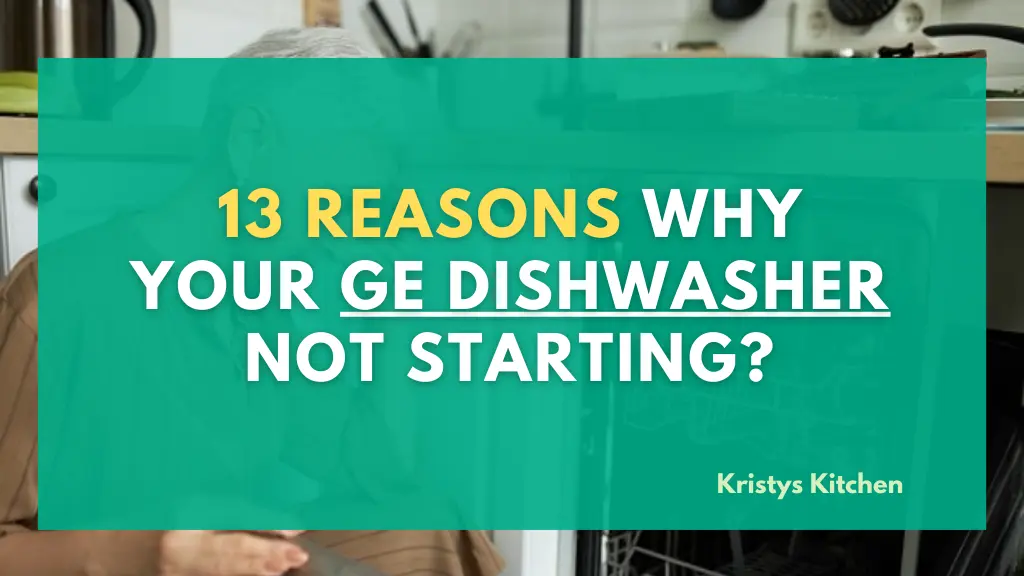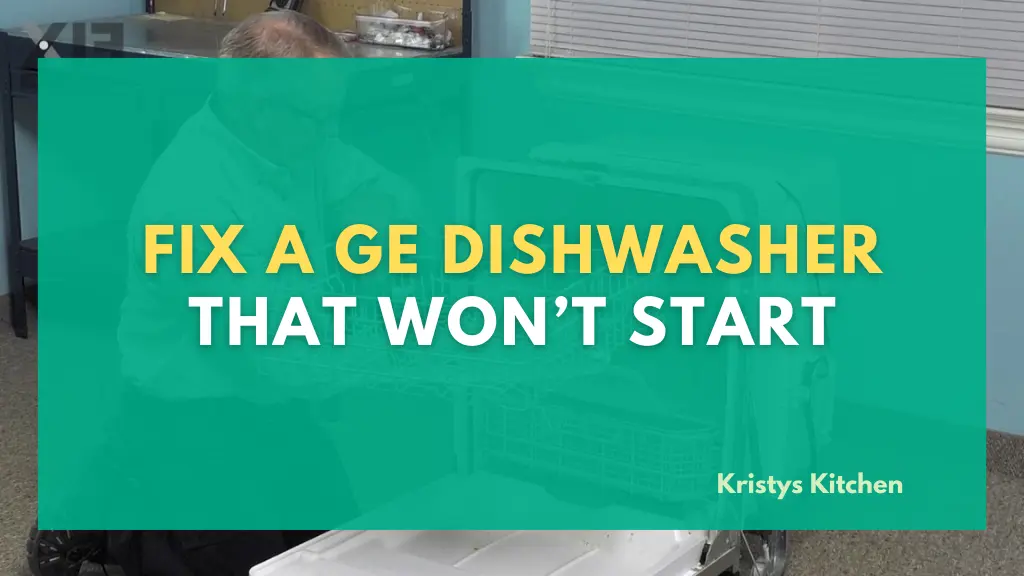13 Reasons Why Your GE Dishwasher Not Starting? (Plus Fixes)
If your GE dishwasher refuses to start, displaying only blinking lights or beeping sounds it can be due to Control Lock, door latch, pump, or power supply issues. Deactivating specific modes, adjusting the door, lubricating seals, and troubleshooting power or water problems will fix this issue.
I’ll tell you everything you need to know to tackle this situation.
So without any further ado let’s get started.
Why is Your GE Dishwasher Not Starting?

Before we delve further, note that these reasons and steps apply when the dishwasher has power but appears unresponsive.
If your GE dishwasher has no power, that’s for an entirely different set of reasons.
With that out of the way, let’s go in-depth with the reasons for your dishwasher not starting.
Reason 1: Control Lock, Delay Start, or Demo Mode Active
Dishwashers today have extra features like Control Lock or Delay Start for convenience.
If these are on, the dishwasher won’t start until those conditions are met or the features are turned off.
Reason 2: Unsecured Door Latch or Faulty Door Switch
The door latch needs to close properly for the dishwasher to start.
If it’s not closing right, it could be due to manufacturing defects, wear and tear, or something blocking it.
Meanwhile, the door switch makes sure the door is closed before the dishwasher starts.
If it’s not working, it might be due to wear and tear, electrical issues, or problems with the sensors that detect if the door is shut.
Reason 3: Pump Seals Dry and Stuck
When dishwashers sit unused for a while, the seals in the pump can dry up.
This makes the pump motor make humming sounds but not start.
So, the dishwasher doesn’t begin its cycle either.
Reason 4: Flood Float Jammed
The flood float prevents flooding.
If it’s stuck due to something in the way or water pressure issues, the dishwasher won’t start to avoid potential flooding.
Reason 5: Activated Leak Detection
If the dishwasher thinks there’s a leak, it won’t start wash cycles to prevent a mess.
Reason 6: Sleep or Sabbath Mode Enabled
GE Dishwashers have energy-saving modes that might make them inactive or follow certain rules during specific times.
In this case, the Sabbath Mode exists for the religious holiday “The Sabbath”.
This being on can cause the control display and control sounds to not respond, making the dishwasher seem non-responsive.
Reason 7: Power Issues
If there’s something wrong with your power supply like sudden changes in voltage or electrical issues your dishwasher will refuse to start as a safety measure.
Reason 8: Blown Thermal Fuses
Thermal fuses monitor heat.
If it gets too high often, due to issues like overheating elements or faulty components the thermal fuse blows, cutting the power, and preventing the washer from starting.
Reason 9: Water Supply Problems
For your dishwasher to work, it needs a steady flow of water at the right pressure and quality.
If anything messes with this like a clog, your dishwasher won’t start.
Reason 10: Incorrect Cycle Settings
When you pick a wash cycle, it’s not just about time.
Your dishwasher needs to match water temperature, detergent amount, and spray arm movements.
Sometimes, these settings might glitch out, causing the washer to not start.
Reason 11: Touchpad or Control Panel Malfunction
Your dishwasher’s controls might be unresponsive.
If the buttons or screen on your dishwasher aren’t working right, it might be a wiring or internal issue.
Reason 12: Timer Component Failure
Your dishwasher has a timer that tells it when to send off power to certain components and at what times.
If this timer messes up, it can throw off the whole sequence of events. That means the dishwasher gets confused and fails to start.
Reason 13: Main Control Board Dysfunction
The main control board coordinates all activities of your dishwasher.
If it’s not working right the dishwasher won’t start, as the control board affects how the dishwasher’s different parts communicate and work together.
How To Fix A GE Dishwasher That Won’t Start?
Now, here’s a guide on how to take care of all these issues.

Solution 1: Deactivating Control Lock, Delay Start, or Demo Mode
These are pretty quick to do, so try to turn off all these modes before trying other fixes.
- Control Lock
- Hold heated dry pad (models with heated dry lock).
- Press the lock pad twice (models with a separate lock pad).
- Delay Start
- Press Delay Start until the delay indicator turns off.
- Alternatively, hold Start/Reset for 3 seconds to cancel any set cycle, including Delay Start.
- Demo Mode
Exiting Demo Mode for GDT225, GDT226, GPT145, GPT225, PDT145 Dishwashers:
- Disconnect power for 30 seconds.
- Reconnect power.
- Press and hold Start and Delay Start for 5 seconds.
Exiting Demo Mode for GDF/GDT/PDT/CDT/DDT/ADT Dishwasher Models (excluding specified ones):
- Disconnect power for 30 seconds.
- Reconnect power.
- Press and hold Start and Heated Dry, Power Dry, or a similar option for 5 seconds.
Solution 2: Fixing Door Issues
- Check the alignment of the dishwasher door latch with the strike plate.
- Adjust the latch position if necessary.
- Tighten or loosen screws for a snug fit.
- Disconnect power to the dishwasher.
- Access and test the door switch with a multimeter for continuity.
- Replace the door switch if it fails the test.
- Inspect the door gasket for wear or damage.
- Replace the gasket following the manufacturer’s guidelines if needed.
Solution 3: Taking Care Of Pump Issues
- Disconnect the dishwasher from power.
- Remove the lower access panel.
- Find the pump impeller and rotate it manually. Apply gentle pressure.
- If stuck, use silicone-based lubricant on seals and impeller.
- Rotate the impeller several times to distribute the lubricant.
- Reassemble, reconnect power, and restart the dishwasher.
Solution 4: Dealing With An Unstuck Float
- Take out both the Ultra Fine and Fine filters.
- Lift the flood float directly from the sump.
- Check for any damage, debris, or bending and straighten them out.
- Swap out the float if it’s in poor condition or return it to its place in the sump if it seems fine.
Solution 5: Deactivating Leak Detection
- Check for leaks and moisture; dry any water.
- Turn off the dishwasher and wait a few minutes.
- Restore power and try a reset.
- If the alert continues, inspect hoses, connections, and seals for leaks.
- Tighten fittings and replace damaged parts.
- Seek help from a technician if issues persist.
Solution 6: Dealing With Power Issues
You’re better off letting an electrician handle this one. Something might be wrong with the electrical outlet itself.
If you still want to try some DIY stuff, here are my suggestions:
- Disconnect the dishwasher.
- Measure the voltage at the dishwasher’s power supply to ensure it matches the recommended range.
- Check the power cord for damage; replace if needed.
- Inspect the junction box for loose connections or damage.
- Tighten connections, repair wires, and ensure proper grounding.
- Reconnect power and check for any issues.
Solution 7: Fixing The Fuse Issue
- Turn off the dishwasher power.
- Locate the thermal fuse behind the inner door near the control board.
- Use a multimeter to check for continuity in the thermal fuse.
- If there’s continuity, you’re good to go and should try the next fix. If not, replace the fuse.
- Turn the power back on and test the dishwasher.
Solution 8: Taking Care Of Water Supply Issues
- Turn off the dishwasher and water supply valve.
- Disconnect the water supply line from the dishwasher’s inlet valve.
- Place a bucket under the line, turn on the valve, and check for steady flow.
- If there’s low pressure (indicated by a weak or inconsistent flow), inspect for kinks or debris in the line.
- If your water is hard, consider installing a water softener for better quality.
- Clear any obstructions and retest water flow.
- Reconnect the water supply line and turn on the valve.
- Check if the dishwasher starts without issues.
Solution 9: Removing Wash Cycle Glitches
- Check the user manual for wash cycle details, including water temperature, detergent, and spray arm movements.
- Inspect the control panel.
- Reset the dishwasher to factory settings.
- Choose your wash cycle and options.
- Start the dishwasher.
Solution 10: Fixing Touchpad/Control Panel Issue
- Disconnect the dishwasher’s power supply.
- Remove the control panel carefully, considering screws or clips.
- Inspect the touchpad ribbon cable for damage.
- Apply electronic contact cleaner to touchpad buttons and control board contacts.
- Reconnect the ribbon cable and reattach the control panel.
- Reconnect power and check for any issues with the dishwasher startup.
Solution 11: Replacing The Timer
You can’t usually test the timer easily or even fix it reliably. That’s why I put it here as one of the last steps – you’re better off replacing it.
Here’s a quick rundown of the process that I used on my GSD2100V50BB GE dishwasher:
- Turn off the dishwasher breaker.
- Remove the timer knob.
- Unscrew and remove the front panel.
- Locate the timer, secured with two screws on the left.
- Unplug the old timer and remove it.
- Transfer necessary components to the new timer.
- Plug in the new timer.
- Reattach the front panel and secure the screws.
- Feed the handle through the opening and secure the lid.
- Turn the dishwasher back on and check for proper functioning.
Solution 12: Dealing With the Main Control Board
If something’s wrong with the main control board, you likely need to replace it.
Here are a few things you can try if you know what you’re doing before you need to go for a replacement:
- Disconnect the dishwasher from the power supply.
- Visually inspect the main control board for damage, burnt spots, or loose connections.
- Examine solder joints on the control board for cracks or poor connections using a magnifying glass.
- Reflow solder joints or replace defective components.
- Reconnect the power and check if the dishwasher starts without issues.
- Use the GE dishwasher diagnostic mode to identify specific issues.
Solution 13: Turn Off Sabbath Mode
Now, let’s end this list of fixes with a rather simple fix. If none of the above worked, then this should.
Check your owner manual in case this combo does nothing:
- Hold down the Cycle Select and Wash Temp pads for a count of 5 seconds.
If you’re still dealing with a non-responsive dishwasher, it might be time to call in experts.
FAQs
Can resetting fix the issue of GE dishwasher not turning on?
Yes, resetting can take care of some issues. Some of the main causes like the wash cycles and touchpad issues can be the result of software glitches.
What is the most common problem with GE dishwashers?
From both my experience and user surveys, it’s usually a GE dishwasher not draining.
Final Thoughts
Hopefully, these troubleshooting tips help your GE dishwasher get back in action.
It’s often a small glitch causing the hiccup, like a mode turned on or a door not closing right.
Give these fixes a shot, and you might save yourself a service call.
